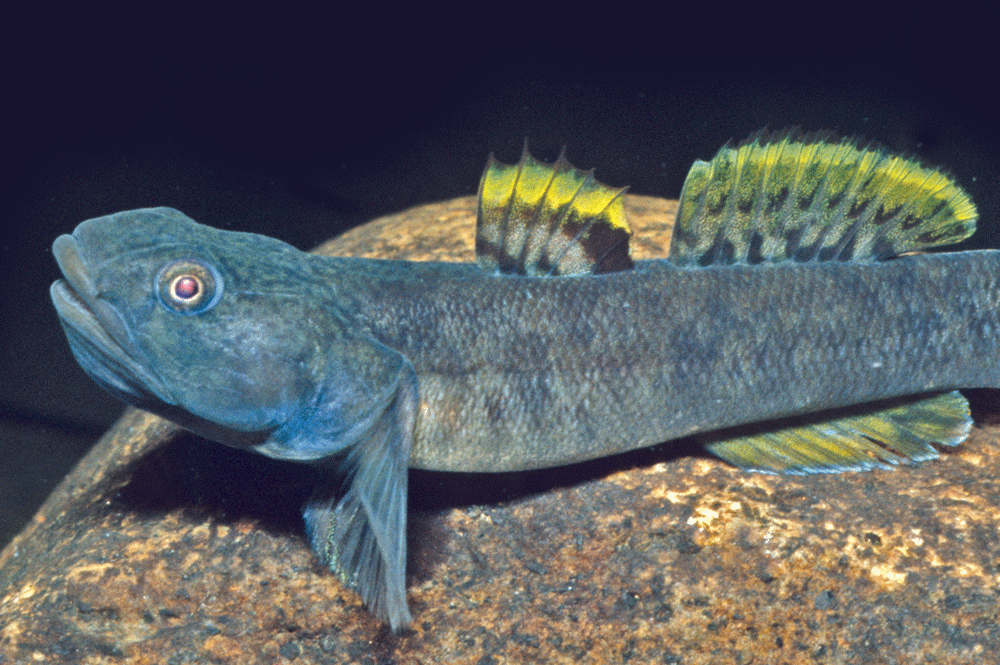- Classification
- ACTINOPTERYGII
- PERCIFORMES
- GOBIIDAE
- Mugilogobius
- platynotus
Flatback Mangrove Goby, Mugilogobius platynotus (Günther 1861)

A male Flatback Mangrove Goby, Mugilogobius platynotus. Source: Rudie Kuiter / Aquatic Photographics. License: All rights reserved
Flatback Mangrove Goby, Mugilogobius platynotus (Günther 1861)
More Info
|
Distribution |
Known only in southern Australia from Maroochy River, southern Queensland, to Western Port, Victoria, and in the Port River estuarine system adjacent to Adelaide, South Australia. The species has been introduced to New Zealand. Inhabits soft silty areas in estuaries, usually amongst mangroves ands salt marsh. Able to tolerate periods of freshwater. |
|
Features |
Dorsal fin V-VI + I, 8-10; Anal fin I, 8-10; Pectoral fin 13-17; Caudal fin (segmented rays) 15-17, (branched rays) 13-16; TRB 16-22; Gill rakers 2-4 + 5-6 = 7-10; Vertebrae 10 + 17. |
|
Size |
To around 6 cm SL |
|
Colour |
Dull brownish grey, mottled, scale margins darker brown, many with midlateral brownish band formed by 9 or more indistinct small dark blotches, band often discontinuous; small rounded brown spot at middle of caudal base; series of broken narrow oblique brownish bars on upper anterior half of body, including brown oblique shoulder bar; some with indistinct brown mottling on side of body and fine dark brownish vermiculations over top and side of head, also with short bars from eye to upper jaw; iris marbled brown and gold with distinct gold rim around pupil. Dorsal fins with broad submarginal yellow band, fin margins dark brown; lower half of first dorsal and lower three-quarters of second dorsal pale greyish brown; first dorsal fin crossed with two longitudinal dark brownish grey streaks and intense black blotch at rear margin, blotch partly extending anteriorly into uppermost dark brownish grey streak; second dorsal with two rows of vertically oriented dark brown spots; anal fin yellowish grey with narrow white margin; caudal, pectoral and pelvic fins plain pale yellowish grey. |
|
Biology |
Likely to be oviparous, benthic spawners. |
|
Etymology |
The specific name platynotus is from the Latin platy (= broad, wide) and notos (= back), in reference to the “broad back” of this species. |
|
Species Citation |
Gobius platynotus Günther, 1861, Cat. Fishes Brit. Mus. 3: 66. Type locality unknown. |
|
Author |
Gomon, M.F. & Bray, D.J. 2023 |
|
Resources |
Flatback Mangrove Goby, Mugilogobius platynotus (Günther 1861)
References
Allen, G.R., Midgley, S.H. & Allen, M. 2002. Field Guide to the Freshwater Fishes of Australia. Perth : Western Australian Museum 394 pp.
Günther, A. 1861. Catalogue of the Fishes in the British Museum. Catalogue of the acanthopterygian fishes in the collection of the British Museum. London : British Museum Vol. 3 586 pp. See ref at BHL
Hammer, M.P. 2006. Range extensions for four estuarine gobies (Pisces: Gobiidae) in Southern Australia: Historically overlooked native taxa or recent arrivals? September. Transactions of the Royal Society of South Australia 130(2):187-196 https://doi.org/10.1080/3721426.2006.10887057
Hoese, D.F. & Larson, H.K. 1994. Family Gobiidae. pp. 781-810, figs 690-714 in Gomon, M.F., Glover, C.J.M. & Kuiter, R.H. (eds). The Fishes of Australia's South Coast. Adelaide : State Printer 992 pp. 810 figs.
Hoese, D.F. & Larson, H.K. 2008. Family Gobiidae. pp. 749-773 in Gomon, M.F., Bray, D.J. & Kuiter, R.H. (eds). Fishes of Australia's Southern Coast. Sydney : Reed New Holland 928 pp. (as Mugilogobius paludis)
Jenkins, G.P. & Hatton, D. 2005. Pop-net sampling to determine whether pale mangrove goby, Mugilogobius paludis, occurs in Corner Inlet/Nooramunga, Victoria. Internal Report No. 52. Primary Industries Research, Victoria.
Johnson, J.W. 2010. Fishes of the Moreton Bay Marine Park and adjacent continental shelf waters, Queensland, Australia. pp. 299-353 in Davie, P.J.F. & Phillips, J.A. Proceedings of the Thirteenth International Marine Biological Workshop, The Marine Fauna and Flora of Moreton Bay. Memoirs of the Queensland Museum 54(3)
Kuiter, R.H. 1993. Coastal Fishes of South-eastern Australia. Bathurst : Crawford House Press 437 pp. (as Mugilogobius paludis)
Kuiter, R. & Kuiter, S. 2018. Coastal sea-fishes of south-eastern Australia. Seaford, Victoria : Aquatic Photographics, 371 pp.
Larson, H.K. 2001. A revision of the gobiid fish genus Mugilogobius (Teleostei: Gobioidei), and its systematic placement. Records of the Western Australian Museum, Supplement 62: 1-233 https://doi.org/10.18195/issn.0313-122x.62.2001.001-233
Roberts, C.D. & Stewart, A.L. 2022. The first record of Australian flatback mangrove goby Mugilogobius platynotus (Günther 1861) (Gobiidae; Tridentigerinae) from New Zealand. New Zealand Journal of Marine and Freshwater Research https:/doi.org/10.1080/00288330.2022.2074059
Whitley, G.P. 1930. Additions to the checklist of the fishes of New South Wales No. 3. The Australian Zoologist 6(2): 117-123 fig. 14 (described as Waiteopsis paludis) See ref at BHL
Whitley, G.P. 1937. Studies in Ichthyology No. 10. Records of the Australian Museum 20(1): 3-24 figs 1-5 pl. 2 https://doi.org/10.3853/j.0067-1975.20.1937.563 (described as Ellogobius abascantus)




